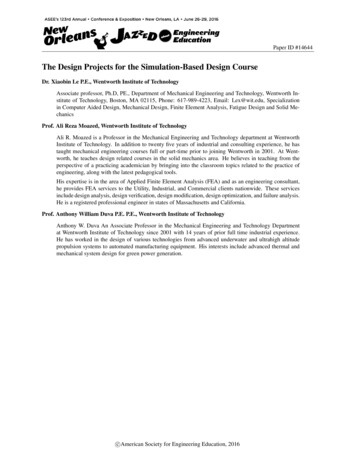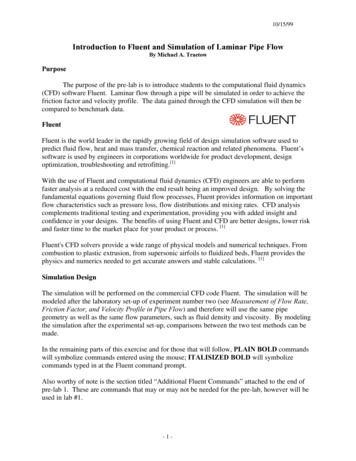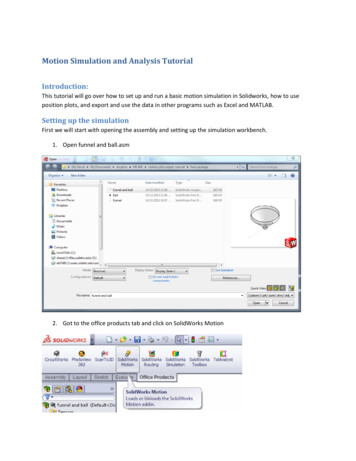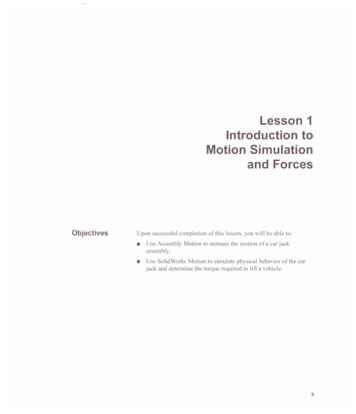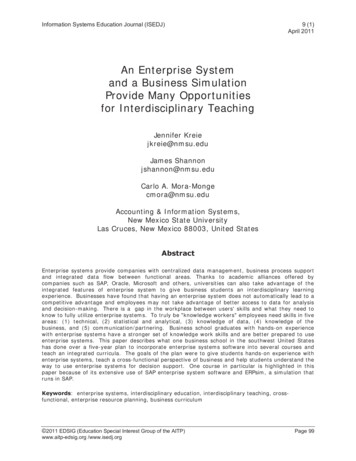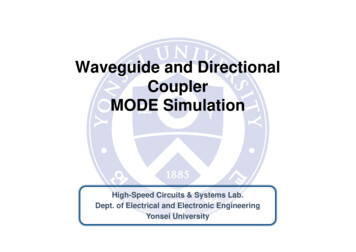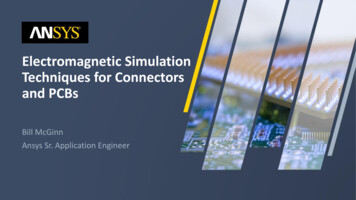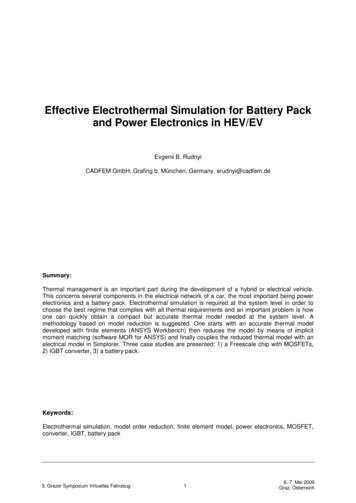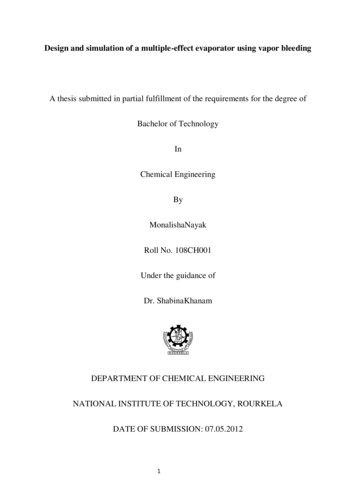
Transcription
Design and simulation of a multiple-effect evaporator using vapor bleedingA thesis submitted in partial fulfillment of the requirements for the degree ofBachelor of TechnologyInChemical EngineeringByMonalishaNayakRoll No. 108CH001Under the guidance ofDr. ShabinaKhanamDEPARTMENT OF CHEMICAL ENGINEERINGNATIONAL INSTITUTE OF TECHNOLOGY, ROURKELADATE OF SUBMISSION: 07.05.20121
ACKNOWLEDGEMENTI express my deep gratitude to my guide Dr. Shabina Khanam, for her everlasting patience and inspiration which led me through this project work.I would also like to acknowledge the contribution of the Department ofChemical Engineering as a whole, andDr. R.K. Singh, HOD, ChemicalEngineering, for having provided us with all the necessary facilities.MonalishaNayakRoll No. 108CH0012
3
DEPARTMENT OF CHEMICAL ENGINEERING,NATIONAL INSTITUTE OF TECHNOLOGY, ROURKELACERTIFICATEThis is to certify that the project entitled “Design and simulation of a Multiple effectevaporator using Vapor bleeding” is an original work done by MonalishaNayak, Roll No.108CH001, under my guidance and supervision.Dr.ShabinaKhanamAssistant ProfessorDepartment of Chemical EngineeringNational Institute of Technology, Rourkela4
LIST OF FIGURESPage no.Fig.2.1. Schematic diagram of a single-effect evaporator16Fig.2.2. Long tube vertical evaporator19Fig 2.3.Climbing film evaporator20Fig.2.4. Falling film evaporator21Fig.2.5. Forced-circulation evaporator22Fig.2.6.Plate-type evaporator23Fig.3.1. Schematic diagram of triple-effect backward feed evaporator29Fig.3.2. Schematic diagram of five-effect forward feed evaporator30Fig.4.1. Block diagram of a single effect in a multiple-effect evaporatorFig.4.2. Schematic diagram of a three-effect backward feed evaporatorwith bleeding53134
Fig.4.3. Schematic of the five-effect forward feed evaporator without bleeding35Fig.4.4.Schematic of the five effect forward feed evaporator with four stage36pre-heatingFig.4.5. Schematic of the five-effect backward feed flow without bleeding38Fig.4.6. Schematic of the five-effect backward flow evaporator with vapor39bleedingFig 5.1.Schematic of the three-effect evaporator with specified variables48Fig. 5.2. Schematic of triple-effect backward feed evaporator with vapor bleeding50showing the different variablesFig.5.3. Schematic of five-effect forward feed system showing the different53variablesFig.5.4. Schematic of the five-effect forward feed evaporator with bleedingFig.5.5.Schematic of the five-effect backward feed evaporator showing the5456different variablesFig.5.6. Schematic of the five-effect backward feed flow system with bleeding658
LIST OF TABLESPage no.Table 3.1. Operating parameters for a three-effect backward feed problem28Table 3.2. Operating parameters for the five-effect evaporator29Table 5.1. Iterative results for the simple three effect system47Table 5.2: Values of different variables for three effect evaporator system48Table 5.3. Values of different variables in the triple-effect backward feed49evaporator with bleedingTable 5.4. Values of variables in the five-effect evaporator system52Table 5.5 Values of variables in the five-effect forward feed evaporator system54with bleedingTable 5.6. Values of variables in the five-effect backward feed evaporator system56Table 5.7. Values of variables in the five-effect backward feed evaporator57system with bleeding7
NOMENCLATUREThe following nomenclature is used in the development of model equations:Symbol ParameterUnitFFeed flow rateKg/sxfConcentration of feed by weight-TfFeed temperature CTiTemperature of ith effect CLiLiquor flow rate from ith effectKg/sxiConcentration of liquor coming out of ith effect-CpiSpecific heat capacity of liquor leaving ith effectKJ/Kg KɽiBoiling point elevation of liquor in ith effect ChiFilm heat transfer coefficient of liquor in ith effect KW/m2KØiHeat flux in ith effectKW/m2ᴫiLinear velocity of liquid on tubes in ith effectKg/m.sViFlow rate of vapor coming out of ith effectKg/sV0Steam flow rateKg/sT0Steam temperature Cλ0Latent heat capacity of steamKJ/Kgλilatent heat capacity of vapor leaving ith effectKJ/KgVbiFlow rate of bleed stream from ViKg/shSpecific enthalpy of liquid phaseKJ/KgHSpecific enthalpy of vapor phaseKJ/KgAiHeat transfer area of ith effectm28
ABSTRACTThe objective of this report is to develop a model for a five-effect evaporator system. Vaporbleeding is incorporated in the model as a means to reduce the amount of steam consumed inthe evaporator. Since evaporation is the most energy-intensive stage in any industrialoperation, measures to reduce energy consumption in the evaporator-house are greatlybeneficial towards making an operation cost-effective. Other energy reduction schemes likecondensate, feed and product flashing, vapor compression etc. are also available. Vaporbleeding brings about an increase in the steam economy of the process, but at the added costof the required heat exchangers.A model for an evaporator used for the concentration of sugar solution is developed using aset of non-linear equations derived from the mass and energy balance relations. Theseequations are then solved using the Newton-Raphson method by developing a matlab codefor the same. For the present system steam requirement without vapor bleeding is computedfirst. Other variables like effect temperatures and liquor flow rates are also a result of themodeling procedure. The same system is then modeled by incorporating vapor bleeding forwhich steam requirement is also found. Additionally, the purchase and installation cost of theheat exchangers required are computed.Vapor bleeding brings an improvement in the steam economy of a process by 26% but at theadded cost 1,50,291 of the five heat exchangers. Annual savings of 43,200 in the cost ofsteam is achieved. The payback period of the modified design of five effect evaporatorsystem is found as 2 years 5 months and 12 days.9
CONTENTSCHAPTER ONE: INTRODUCTION . 12CHAPTER TWO: LITERATURE REVIEW . 152.1. Different types of evaporators . 152.1.1.Horizontal tube evaporators . 162.1.2. Horizontal spray-film evaporators . 162.1.3. Short tube vertical evaporators . 172.1.4. Basket type evaporators . 172.1.5.Long tube vertical evaporators . 182.1.7 Climbing film evaporators . 192.1.8. Falling film evaporators . 192.1.9. Rising falling film evaporators . 202.1.10 Forced circulation evaporators . 212.1.11. Plate type evaporators . 222.2. Modeling of a multiple effect evaporator system . 22Equation-based model . 22Cascade algorithm . 232.3. Energy Reduction Schemes(ERSs) in evaporators. . 242.3.1. Flash evaporation. 242.3.2. Vapor compression . 242.3.3. Vapor bleeding . 252.4. Sugarcane juice . 26CHAPTER THREE: PROBLEM STATEMENT . 273.1. Problem I . 273.2. Problem II . 28CHAPTER FOUR : DEVELOPMENT OF THE MODEL AND SOLUTIONPROCEDURE . 304.1. Model development for a particular effect . 304.2. Model development for the three effect backward feed evaporator . 324.3. Model development for the three effect backward feed evaporator with bleeding . 334.4. Model development for the five- effect forward feed evaporator without bleeding . 344.5. Model development for the five-effect forward feed evaporator with bleeding . 3510
4.6. Model development for the five-effect evaporator operated in backward feed flow withoutbleeding . 374.7. Model development for the five-effect evaporator operated in backward feed flow withbleeding . 384.8. Solution of the model: Newton Raphson method [2] . 404.9. Empirical correlations for specific heat, boiling point rise, latent heat and heat transfercoefficient . 404.10. Detailed iterative solution procedure of the three-effect backward feed evaporator . 414.11. Detailed iterative solution procedure of the five-effect backward feed evaporator withbleeding . 43CHAPTER FIVE: RESULT AND DISCUSSION . 455.1. Three effect evaporator operated in backward-feed flow sequence . 455.2. Three-effect evaporator system with vapor bleeding . 485.2.1 Associated costs . 495.3. Five-effect forward feed evaporator . 515.4. Five-effect forward feed evaporator with vapor bleeding. 525.4.1 Costs computation . 545.5. Five effect evaporator operated in backward feed flow without bleeding . 545.6. Five-effect backward feed evaporator with vapor bleeding . 56CHAPTER SIX : CONCLUSION . 58REFERENCES . 59APPENDIX . 6111
CHAPTER ONE: INTRODUCTIONEvaporators are used in a process industry to concentrate solutions consisting of a nonvolatile solute and volatile solvent, like foods, chemicals, etc. In a majority of the processes,the solvent is water. Dilute solutions contain a large amount of water, and the cost ofprocessing such solutions involves a high equipment cost. The evaporation process proceedsby evaporating a part of the solvent from the solution to increase its concentration. Thisevaporation is carried out by using steam as the heating medium. Normally, the thick liquorobtained is the valuable product. The material of construction of an evaporator may be anykind of steel. Special materials like copper, stainless steel, nickel, aluminium may be useddepending upon the specific properties of the solution to be concentrated.When a single evaporator is used for concentration, the vapor issuing out of it is condensedand discarded. This type of operation is called single-effect evaporation. When a number ofeffects are used in series, such that the vapor coming out of one effect is used as a heatingmedium in the steam chest of the next effect, it is called multiple effect evaporation. Singleeffect evaporation is simple but fails to utilize the steam effectively, while multiple effectevaporators evaporate more quantity of water per kilogram of steam consumed in theevaporation process. This brings about a saving in the steam cost, but at the same time, thecost of material and installation of the evaporator system increases because of the largenumber of effects involved. There has to be trade-off between the material cost and the stea
Fig 2.3.Climbing film evaporator 20 Fig.2.4. Falling film evaporator 21 Fig.2.5. Forced-circulation evaporator 22 Fig.2.6.Plate-type evaporator 23 Fig.3.1. Schematic diagram of triple-effect backward feed evaporator 29 .

